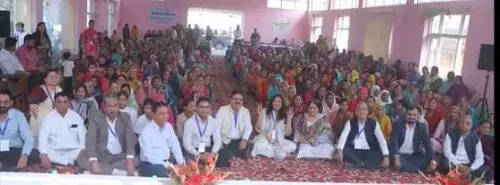The Role of India’s Public Distribution System in Tackling Stunted Growth

Synopsis
Key Takeaways
- 1.8 million children have been saved from stunting.
- The PDS has expanded significantly since 2013.
- Food transfers improve dietary diversity and nutrition.
- Infants aged 0 to 2 years benefit the most.
- PDS supports resilience against adverse weather impacts.
New Delhi, Feb 26 (NationPress) The expansion of India’s public distribution system (PDS) has been pivotal in combating stunted growth, a critical health issue affecting children across the nation. A recent study published by the American Economic Association indicates that this initiative has successfully prevented approximately 1.8 million children from experiencing stunting in eight Indian states.
The findings reveal that the National Food Security Act (NFSA) food transfer program has not only reduced stunting rates but also contributed to increased wage earnings and enhanced dietary diversity nationwide.
Initially broadened under the NFSA in 2013, the PDS was further strengthened in response to the Covid-19 pandemic through the Prime Minister’s Garib Kalyan Anna Yojana (PMGKAY) in 2020. This initiative ensures that individuals receive 5 kg of staple grains per month at subsidized rates of ₹3 per kg for rice and ₹2 per kg for wheat.
The study assessed the impact of the NFSA on child stunting, nutrition, and dietary diversity, illustrating that food transfers alone can significantly lessen child stunting in developing nations. Stunting is a primary metric for evaluating childhood malnutrition, indicating that a child has not achieved their growth potential due to illness, inadequate health, and poor nutrition.
Researchers from IIM Bangalore and the universities of California and Calgary selected households with ration cards from 30 villages across eight states: Andhra Pradesh, Bihar, Gujarat, Jharkhand, Karnataka, Madhya Pradesh, Maharashtra, and Odisha.
Results indicated that an increase in PDS transfers enhanced dietary diversity and led to higher consumption of nutrient-rich foods.
The study noted, “PDS transfers boost the proportion of the food budget allocated to animal proteins while reducing expenditure on grains. The substantial increase in nutrient intake accounts for our primary finding of reduced stunting,” as stated in the paper.
This improvement arises because the initiative lessens out-of-pocket costs for staple foods, allowing families to allocate more resources toward nutrient-dense foods, according to the researchers.
Interestingly, the impact was most significant for infants aged 0 to 2 years, aligning with the critical first 1,000 days of life when nutritional intake is crucial for development, according to the researchers.
Despite challenges such as adverse weather conditions—like insufficient rainfall or drought—that typically exacerbate child stunting, the study found that PDS transfers resulted in a 7 percentage point reduction in stunting during years marked by negative rainfall shocks.
“These findings imply that a nutrition-sensitive safety net, such as the PDS, bolsters food security, making child nutrition outcomes more resilient to local climate disturbances,” the research team concluded.









